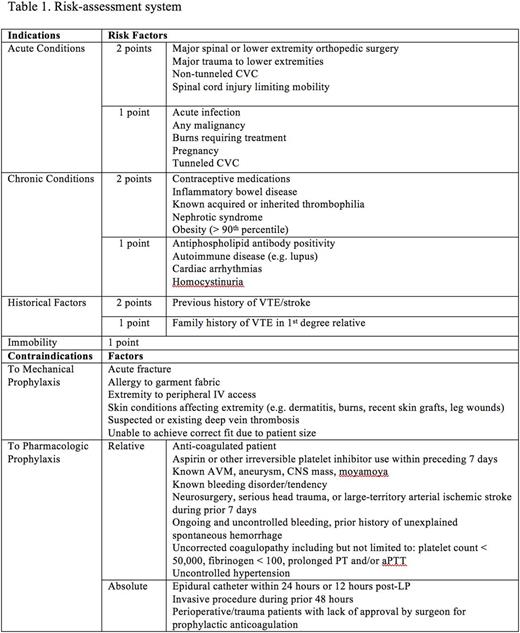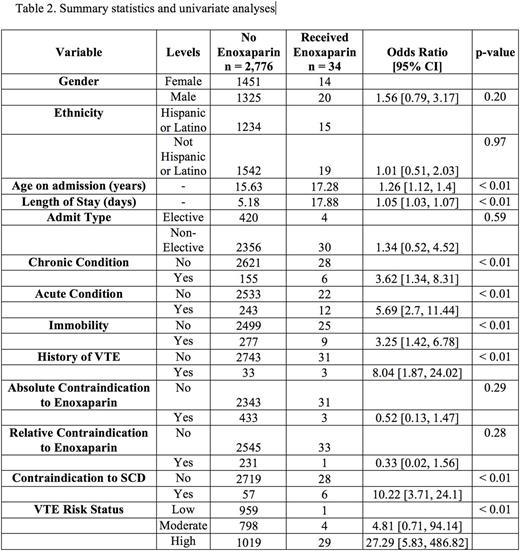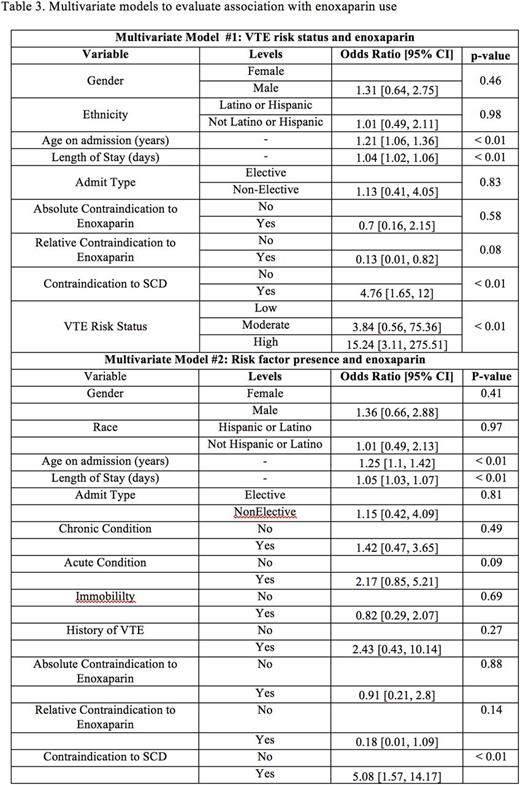Abstract
Background
Pediatric hospital-acquired venous thromboembolism (HA-VTE) incidence is rising and many centers have instituted guidelines for use of both mechanical and pharmacologic prophylactic measures.
Objectives
The primary objective of this work was to evaluate the pattern of enoxaparin use in eligible patients admitted to Children's Hospital of Orange County (CHOC) in the first 17 months from inception of the prophylaxis program.
Methods
CHOC has a risk-assessment program (Table 1) for patients > 12 years admitted for > 24 hours with categories of low (0 points), moderate (1 point), and high (> 2 points). The primary service admitting the patient was responsible for the risk-assessment. Low risk patients do not receive prophylaxis recommendations. Moderate risk patients are recommended to receive mechanical prophylaxis (mTP) in the absence of contraindications. High risk patients are recommended to receive mechanical prophylaxis and a Hematology consultation to determine use or not of pharmacologic prophylaxis (pTP).
Univariate analyses were conducted on risk factor categories and those significant (p<0.05) were included in 1 of 2 multivariate logistic regression analyses. Since VTE risk status is calculated from components of the risk-assessment (i.e. acute and chronic conditions, immobility, history of VTE) a model with these variables may not also include the output variable, i.e. VTE risk status. This is to prevent potential confounding and problems due to multicollinearity. The first model evaluated likelihood of pTP relative to VTE risk status and the second model relative to chronic conditions, immobility, and historic factors (independent of VTE risk status).
Results
3557 patients were eligible and 2846 (80%) had the risk-assessment form completed. 36 (1.3%) of these patients had incomplete data yielding a total of 2810 patients for analyses. Of those 2810, 34 (1.2%) patients received pTP. The female:male ratio was 1.1:1 and age distribution (n, %) by year was: 12 (369, 13.1%), 13 (383, 13.6%), 14 (443, 15.7%), 15 (476, 16.9%), 16 (419, 14.9%), 17 (339, 12%), 18 (152, 5.4%), 19 (101, 3.6%), 20 (83, 2.9%), 21 (25, 0.9%), 22 (3, 0.1%), 23 (5, 0.2%), 24 (5, 0.2%), 25 (1, 0.04%), 26 (4, 0.14%), 27 (1, 0.04%), 33 (1, 0.04%).
Univariate analyses (Table 2) revealed significance of increasing age [p<0.01, OR 1.26 (1.12-1.4)], increasing length of stay (LOS), [p<0.01, OR 1.05 (1.03-1.07)], presence of a chronic condition [p<0.01, OR 3.62 (1.34, 8.31)], acute condition [p<0.01, OR 5.69 (2.7-11.44)], immobility [p<0.01, OR 3.25 (1.42-6.78)], history of VTE [p<0.01, OR 8.04 (1.87-24.02)], presence of a contraindication to mTP [p<0.01, OR 10.22 (3.71-24.1)], and risk status of high [p<0.01, OR 27.29 (5.83-486.82)].
The first multivariate model (Table 3) revealed significance of increasing age [p<0.01, OR 1.21 (1.06-1.36)], increasing LOS [p<0.01, OR 1.04 (1.02-1.06)], contraindication to mTP [p<0.01, OR 4.76 (1.65-12)], and risk status of high [p<0.01, OR 15.24 (3.11-275.51)]. The second multivariate model (Table 3) confirmed significance of increasing age [p<0.01, OR 1.25 (1.1-1.42)], and contraindication to mTP [p<0.01, OR 5.08 (1.57-14.17)].
Conclusions
There is a lack of evidence-based guidelines for VTE prophylaxis in pediatrics. Prophylaxis programs and practice patterns likely have wide variation, therefore, the objective of this work was to identify the practice pattern at a single children's hospital in the first 17 months of the program. Utilization of pTP was low overall and associated with increasing age, increasing LOS, contraindication to MTP, and a risk status of high.
It is accepted practice to utilize VTE prophylaxis in adults and this likely played a role in the increasing likelihood of pTP with increasing age. The higher likelihood associated with increasing LOS likely reflects that risk of HA-VTE increases with longer LOS. The association with high risk status was intended with design of the program and the association with a contraindication to mTP likely reflects that patient severity was deemed significant enough to warrant prophylaxis and pTP was the only remaining option.
Pediatric VTE prophylaxis programs are becoming more prevalent despite a lack of evidence-based guidelines. Understanding patterns of prophylaxis use may help guide crucial comparative studies to assess efficacy, safety, and cost-benefit.
No relevant conflicts of interest to declare.
Author notes
Asterisk with author names denotes non-ASH members.




This feature is available to Subscribers Only
Sign In or Create an Account Close Modal